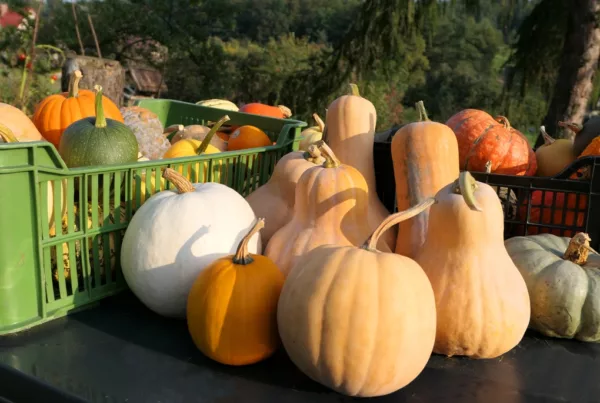Written by Kristina Hicks-Hamblin
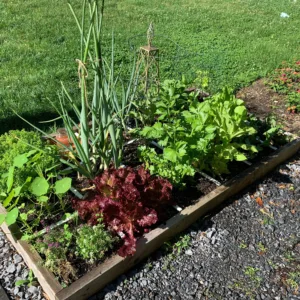
Springtime is the perfect time to get busy in the Square Food Garden, but you can’t grow just anything during these cool days. You’ll need to wait to plant tender crops like melons, squash, cukes, tomatoes, and peppers until after your last average frost. However, before temperatures start to warm up, there are plenty of other crops to plant in spring!
The Perfect Crops to Plant in Spring
The following cool season crops can be grown from sowing seed directly into your Square Foot Garden raised beds in spring:
Beets
Beets are sown 1/2 inch deep, at a spacing of 16 per square foot, or 9 for larger varieties.
Sow seeds two to four weeks before the last average frost, expect germination in five to 21 days, and harvest in roughly 70 days.
If you’d like more guidance on growing this root crop, check out our blog post on growing beets.
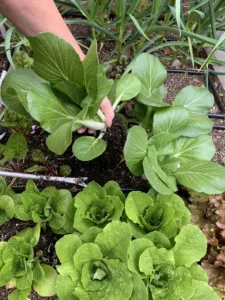
Bok choy is planted four per grid section.
Bok choy
Sow bok choy seeds 1/4 inch deep, at a spacing of four plants per grid section, two to four weeks before the last average frost.
Seedlings should emerge in five to 10 days, with harvest in approximately 50 days.
Carrots
Sow carrots seeds 1/4 inch deep, with a spacing of 16 plants per square, two to four weeks before the last average frost.
Be patient – it can take 10-25 days for germination. Carrots will be ready to harvest around 65 days after planting.
If growing long carrot varieties in the SFG, be sure to use a top hat for increased soil depth!
Cilantro
One to two weeks before the last average frost, sow a pinch of three cilantro seeds 1/2 inch deep in the middle of a grid section, since this herb grows to be quite large when allowed to flower. You don’t have to let your cilantro flower, but the pollinators will love it!
Expect germination in 10 to 15 days.
You can start harvesting when plants are a few inches tall, taking care not to remove all the leaves from the plant at once for continued growth.
Chives
Four to six weeks before the last average frost, sow a group of 10 chive seeds 1/4 inch deep, at a spacing of 16 per square foot. Expect seedlings to emerge in 10 to 15 days. Wait until chives are at least six inches tall before harvesting, cutting back to two inches long for continued growth.
Chives are perennial in USDA Hardiness Zones 4-8, so you might want to start these in a dedicated perennial herb bed.
Daikon Radishes
Daikon radishes are sown nine or four per grid section, depending on the size of the variety.
Sow daikon eight weeks before the last average frost and 1/2 inch deep. Germination should occur in five to 10 days, and roots will be ready to harvest in approximately 60 days.
Dill
Plant dill one to two weeks before the last average frost, sowing seeds at a spacing of nine plants per grid section in the Square Foot Garden.
Press the seeds into the surface of damp soil without covering them. And don’t sit around waiting for these to pop up – dill is slow to emerge, taking 20 to 25 days to germinate.
Allow plants to grow four or five inches tall before harvesting, picking only a few leaves at a time while young dill plants get established.
Kale and Mustard Greens
Kale and mustard greens are both grown one plant per grid section.
Sow both of these brassicas 1/4 inch deep. Plant kale one to two weeks and mustard four to six weeks before the last average frost, and expect germination in 5 to 10 days.
You can harvest kale starting when it is just four inches tall for baby leaves, taking outer leaves first, and harvesting no more than one third of the foliage at a time for good regrowth.
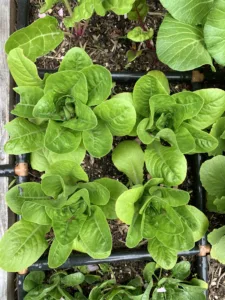
Lettuce growing in Mel’s Mix.
Lettuce
Spacing for lettuce depends on which type you grow – grow heading varieties two per square foot, and leaf varieties four in each grid section.
Plant seeds two to four weeks before the last average frost, pressing a pinch of two or three seeds into the surface of moist soil without covering them.
Look for emerging seedlings in five to 10 days. You can start harvesting outer leaves when plants are a few inches tall, but don’t harvest more than a third of the plant at a time. That way these baby lettuces will have the energy they need to keep growing.
Onions
Sow onion seeds 1/4 inch deep, four to six weeks before the last average frost, at a spacing of 9 per grid section for bulbing onions, and 16 per section for bunching onions.
Wait seven to 15 days for onions seedlings to emerge, and count on approximately 65 days to maturity for bunching varieties, and 120 days for bulb types.
Parsley
Four to six weeks before the last average frost, sow parsley seeds, placing them 1/4 inch deep, at a spacing of four per square foot.
Don’t be disappointed if you don’t see baby parsleys right away – these take 14 to 28 days to emerge.
Allow plants to grow to a few inches tall before picking sprigs of this herb – and once you start harvesting, only take one third of the plant at a time to ensure good regrowth.
Peas
The best spacing for peas is 8 per grid section. You’ll want to sow peas four to six weeks before the last average frost, at a depth of one inch. Baby pea plants will appear in five to 10 days, and will be ready to harvest in roughly 70 days.
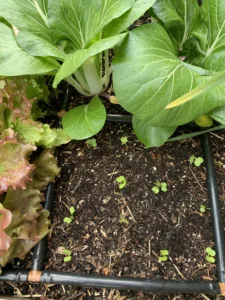
Radish seedlings in a spring garden.
Radishes
Radishes are sown 1/2 inch deep, at a spacing of 16 plants per grid section. Start sowing four to six weeks before the last average frost.
For a continuous harvest, keep sowing radishes in new grid sections every one to two weeks before the last average frost. That means if you’re really keen on these spicy roots, you could plant radishes every week for six weeks in a row!
Radishes are fast growers, and they will sprout in five to 10 days. Depending on the variety, you may be able to harvest fresh radishes in less than a month.
Get more tips on growing radishes in raised beds with our blog post!
Spinach
Sow spinach 1/2 inch deep, at a spacing of nine plants per square, four to six weeks before the last average frost.
Look for spinach seedlings in five to 10 days after sowing. Pick outer leaves only when plants are at least a few inches tall, in approximately 28 days.
Swiss Chard
Sow Swiss chard seeds two to four weeks before the last average frost, 1/2 inch deep, at a spacing of four plants per grid section.
You’ll see seedlings raise their heads above the Mel’s Mix in five to 10 days. Once plants are at least four inches tall, you can start to harvest outer leaves, but never more than one third of the plant at a time for continued growth.
Turnips
Sow turnip seeds 1/4 inch deep, nine per square foot, two to four weeks before the last average frost.
Expect to see seedlings in five to 10 days, and plan on harvesting in roughly 40 days, depending on the variety.
Other Spring Crops
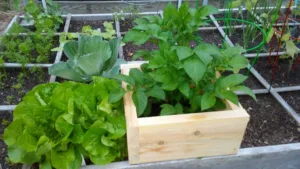
Potatoes growing in a SFG top hat.
Some cool weather crops such as strawberries, celery, broccoli, cauliflower, and cabbage do best when grown indoors and transplanted out rather than direct sowing them.
You can start these indoors in a sunny windowsill or under a grow light during winter or early spring, and then transplant them into your Mel’s Mix after seedlings have matured and you have hardened them off.
If you miss your window for starting them yourself, you may be able to find seedlings for your Square Foot Garden from a local nursery.
Potatoes can also be planted in springtime, using a top hat to increase soil depth.
Need more help getting started? Read our article on planning a spring garden!



